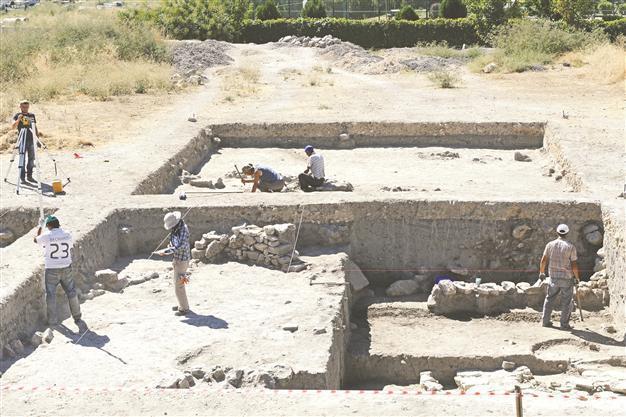Oldest settlement comes to light in Turkish capital
ANKARA - Anatolia News Agency

Ongoing excavations in Çayyolu unearth pieces of objects such as ceramics, pottery, hair ties, stamps, animal figures and beads. DAILY NEWS photo, Selahattin SÖNMEZ
A recently discovered burial mound in the heart of an Ankara neighborhood could shed more light on the area’s Bronze Age past and even older eras, according to the Culture and Tourism Ministry’s undersecretary.
“This archaeological work is very important in terms of the history and chronology of the region,” Özgür Özarslan said Sept. 11 about the archaeological excavations that began last year in Çayyolu. “I believe that more significant objects will be unearthed in this area.”
He said the area was home to samples from the Bronze Age and that they also hoped to reach older periods in the vicinity.
Özarslan said the excavation area was an old settlement and that they had discovered pieces of things such as architectural structures, ceramics, pottery, hair ties, stamps, animal figures, beads and more objects that cast light on the lifestyle of the former inhabitants.
“It is not a common thing in the world to make an archaeological excavation in a city center, in a living space,” said Özarslan, highlighting the difference between the Çayyolu mound and other archaeological sites.
The mound was turned into an archaeological area with the contribution of locals, Özarslan said.
“Awareness has been raised and this work is being carried out with contributions from the Culture Ministry, museums, business places, public and governors. We think of this place as an education area, an archeopark. This is the same all around the world. Museums, ancient sites and archaeological areas are seen as education places for schools. This is why we are organizing this area as an archeopark.”
The undersecretary also said it was a civic responsibility to inform the ministry about such findings during construction work. When asked about the effects of the Çayyolu excavation area on the modern settlements in the vicinity, Özarslan said: “I believe that this will be understood during later works. If there is such an effect, the state has some legal alternatives like expropriation. But I don’t think right now that it will be necessary. Places like this should be determined beforehand and the settlement plan should be made according to it. This is why inventory work on the area is very important.”
 First excavation over the last 50 years
First excavation over the last 50 yearsA consultant for the excavation area, Ahi Evran University member Associate Professor Gülçin İlgezdi Bertram, said it was the oldest settlement in Ankara.
Bronze Age excavations were first carried out in the 1930s in Ankara at Ahlatlıbel and Karaoğlan in accordance with the will of Mustafa Kemal Atatürk, the founder of the Turkish Republic, and then in Koçumbeli in 1960, she said.
“No excavations on Bronze Age areas were carried out for the next 50 years. This is why the work on the Çayyolu mound is very important,” she said.
Bertram said finds in the area dated back to the Bronze Age between 3,000 and 5,000 B.C. and that they would continue working until Nov. 15.
“We are now working to go deeper. There is a chance to reach the Chalcolithic age,” she said.
Meanwhile, Museum of Anatolian Civilizations Director Melih Arslan said they were preparing a new section in the museum to display works of art unique to Ankara. “We will open this section in October.
There will be complete works from the first civilization in Ankara to the Byzantine period.”

 First excavation over the last 50 years
First excavation over the last 50 years